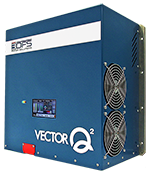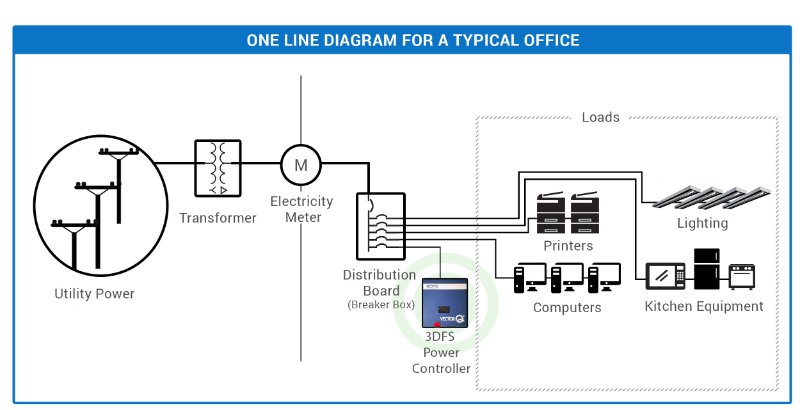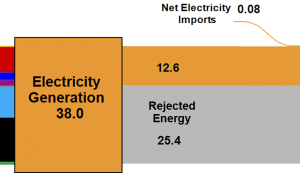
Software-Defined Electricity: The First Digital Solution for Electricity Correction and Power Distribution
During the first 90 years of the Grid, electricity was mainly used for motors and incandescent lights. That meant nearly a century of growth providing electricity to homes and businesses for relatively predictable purposes.

In the last 35 years, we have increased our reliance on computers and precision electronics throughout every sector and in every area of our country. This shift from static and predictable electricity usage to dynamic and less predictable usage has generated a host of problems that the Grid was not designed to handle.
The technologies and infrastructure that make up the grid are entirely analog. The result of this inefficient distribution are losses of nearly 70% of the electricity that is generated. The losses occur throughout the entire grid, at generation, through transmission and distribution, at the grid edge, in the last mile of transmission after the final substations and in our homes and businesses.
These losses along with instability problems are the precise reason that we cannot confidently plan our energy future as a country. There are well known issues with the electrical infrastructure in the U.S. Some common themes are
- needing a “two way distribution grid”
- enormous increase in power outages from aged infrastructure
- the importance and challenges of grid level energy storage
- how power quality and energy efficiency are linked
- the importance and challenges of microgrids
The static and analog solutions of today are not a reliable methodology to build the Grid of the future on and the country as well as the rest of the world is stuck in this conundrum.
Technology – Software-Defined Electricity
 We have developed an innovative energy technology with unique capabilities. It is a computer system built with a combination of computer and power electronics roughly the size of microwaves built using off the shelf, UL listed components. They are called VectorQ Series Power Controllers. The computer language and machine code that drive the power controllers are proprietary, written for the explicit purpose of interfacing directly with electricity with at ultra high speeds with optimum efficiency.
We have developed an innovative energy technology with unique capabilities. It is a computer system built with a combination of computer and power electronics roughly the size of microwaves built using off the shelf, UL listed components. They are called VectorQ Series Power Controllers. The computer language and machine code that drive the power controllers are proprietary, written for the explicit purpose of interfacing directly with electricity with at ultra high speeds with optimum efficiency.
Each power controller serves two purposes. First they correct and balance the electrical network and intelligently distribute power within each distribution panel with absolute precision so that zero electricity is wasted. Second, they report a portion of the electricity data collected to a dashboard through an internet connection to provide real time data, non-intrusive load monitoring, predictive analytics, and software control of the power in the network.
The result is something similar to a real time operating system for electrical networks that automatically manages the electrical environment with the speed, precision, and repeatability of computers. The dynamic monitoring and electrical digital correction significantly improves the quality of electrical service by maintaining electrical balance and essentially “self healing” when the network is disrupted by any electrical disturbance.
The acquisition of real time granular electrical usage data within the electrical environment opens up new new markets.
The acquisition of real time granular electrical usage data within the electrical environment opens up new new markets. This data is disaggregated in real time and allows any device in an electrical environment to be precisely identified, tracked, and logged. Over time, individual energy usage profiles for each device are built and can be reviewed for historical use, predictive analytics, and energy use forecasting all with stunning detail and accuracy light years ahead of what has ever been possible.
How it does it?
There are many innovations to the technology, but there are two that are the most inquired about.

The data acquisition and processing power of each power controller is enormous and is accomplished using conveyor matrix computing. Most of the acquired data is analyzed, processed and immediately dumped with the necessary corrections occurring continuously in real time. This method of processing allows the Software-Defined Power Controllers to acquire, analyze, and process over 294 million data points every second, roughly 50,000 times the amount of data that is currently acquired using smart meters.
The real time correction is done non-invasively by digitizing and acquiring real-time electrical environment data at the nanosecond time frame, analyzing and processing it, and then injecting the exact required Current back into the electrical environment at precisely the correct time in order to perfectly counterbalance the distortions and imbalances present in the individual Current and Voltage waveforms. This approach to electrical correction is exact and uses a fraction of the electricity that is currently used and produces superior results to the existing imprecise analog technologies.
There are many more complexities and subtleties involved, but this description seems to be both accurate and easy to understand.
What does this mean for…?
Electrical networks in our homes and businesses
The results of a perfectly balanced electrical environment without harmonic distortions, power factor, voltage sags or swells, neutral currents, imbalanced phases, and a host of other electrical distortions are an improvement in energy efficiency, reduced costs, and improved performance of every device that is connected to our home and business electrical networks. Software-Defined Electricity will eventually replace many of the energy technologies that currently make up many global markets worth billions of dollars which are expected to grow, grow, grow for the foreseeable future.

From a Consumer perspective, (home and business consumers of electricity), they will experience a higher quality of electrical service with fewer power disturbances and exclusively available data and analytics capabilities. The consumer will pay less money by using less power and will not pay for any penalties related to power quality or phase balancing (which can be 30%-50% of commercial and industrial power bills). There will also be a significant decrease in repair and maintenance costs of assets. With SDP, the electrical networks will be optimized at all times from a cost and power perspective automatically without any human interaction.
From a Utility perspective, the consumer no longer experiences power disturbances that originate from the grid and they reduce their power consumption, easing the burden of power delivery during peak demand. Upstream substations no longer experience wear and tear from imbalanced consumer loads or returning reactive power onto the grid. This saves millions of dollars annually on repairing and replacing transformers, reclosers and other grid infrastructure. Also, less electricity is wasted in distribution to consumers because of the real time balanced power usage, saving the Utility more money.
Renewables
Software-Defined Electricity increases the production of electricity generated by any renewable energy sources through the real time optimization of electricity. It also converts DC to AC, AC to DC, or DC to DC at a true 98% efficiency. This will eventually replace traditional analog converters and inverters because significantly more electricity is produced from all renewable sources with the real time optimization and management. Ultimately, renewables become more productive, last longer, and are more profitable (without subsidies) with much more reliable and consistent data and analytics.
Battery Management System
Software-Defined Electricity increases the operating life of batteries by increasing the number of charging cycles up to 2.5 times and maintains optimum performance so they hold the same amount of charge for the duration of their life. By intelligently managing batteries, SDE prevents them from heating up in the charging and discharging process, which is simply another form of electrical waste related to analog methods. Combined with a source of renewables and our technology can produce a stable microgrid for any sized electrical network or grid and completely optimizes the distribution of electricity as it sits at the nexus of generation, grid power, renewables, and consumer power use.
Microgrids
The dynamic self-healing nature of SDE allows for multiple generation sources to be linked together seamlessly without the interconnection problems that currently exist related to islanding and excessive waste from non-optimized power. Only with SDE can microgrids quickly, safely, and efficiently island without power disturbances and fuel savings of 59.4% have been recorded in all diesel generator based microgrids. All microgrid sources and loads can be individually monitored and logged for historical records and predictive analytics, which is critical in microgrid situations due to the reduced access to power.
Two-Way Distribution System
One of the most important aspects of SDE is that it monitors and corrects the electricity in real time and provides data communication capabilities throughout the grid. By installing SDE, an electrical network is immediately converted from a one way power distribution system to a two way power distribution and communication system.
By installing SDE, an electrical network is immediately converted from a one way power distribution system to a two way power distribution and communication system.
U.S. Grid
Our Grid is antiquated and in dire need of infrastructure upgrades. Our system is scalable and can be installed throughout the Grid to provide the same dynamic stability that is provided to electrical networks with the same data and predictive analytics capability. SDE will allow the grid to operate with the flexibility to withstand power disturbances, dramatically reducing the number of power outages through the U.S. Grid.
Economic Development
3DFS Software-Defined Power is a North Carolina based Limited Liability Company. We currently do all of our manufacturing in Pittsboro and are expanding to a 10,000 sq ft. complex, also in Pittsboro. With the new manufacturing facility, we hope to add between 30 and 40 full time jobs to the area by the end of 2017.
This technology has many different avenues for licensing and in all of our prospective partner discussions, there is a required manufacturing component. Some of the manufacturing is electronics manufacturing that can be accommodated in our new complex, but many other applications require additional manufacturing locations to be set up, We plan to perform all of the advanced manufacturing in and around Pittsboro, NC and will eventually expand outside of NC as our supply and distribution chain are developed.
In the next 10 years, we anticipate to be one of the largest employers in the state of NC and expect to be the largest employer in North Carolina within 15 years.
In the next 10 years, we anticipate to be one of the largest employers in the state of NC and expect to be the largest employer in North Carolina within 15 years. The capabilities provided by our technology also creates an enormous amount of ancillary startup business opportunities, with our data as a service, power conditioning as a service, and predictive analytics as a service, in addition to the numerous product companies that can be created.
An alternate view on how we are going to improve the economic development in the area is by providing ideal power. Providing stable grid power and grid level storage will soon prove to be the biggest incentive to move to a location. We would like to up fit and improve North Carolina’s quality of electrical service in order to put the state on top of the list for prospective companies to move. We are actively looking to build this plan and our goal is to begin with Chatham Park.




Paul Otham
i am interested to receieve ur news letter
Clifton Bukowsky
We are building 6 Tri Modal Inland Ports and each will be over 1000 acres with multiple tenants (logistics and manufacturing hubs) and likely will have our own grid. Closing on all six sites in the next 3-6 months with design and construction on each to begin within 12 months. Interested in talking to you about utilizing the technologies at the sites